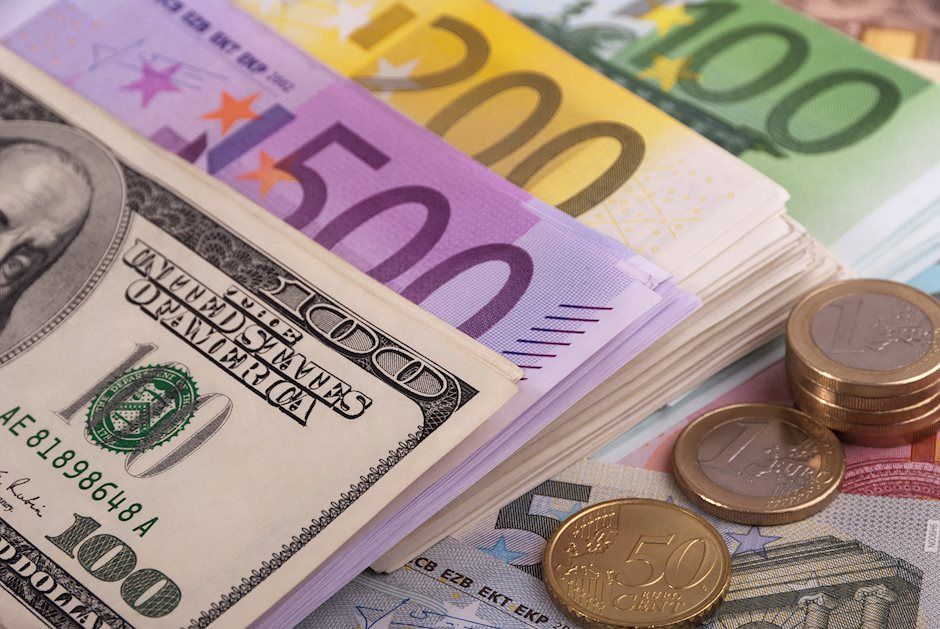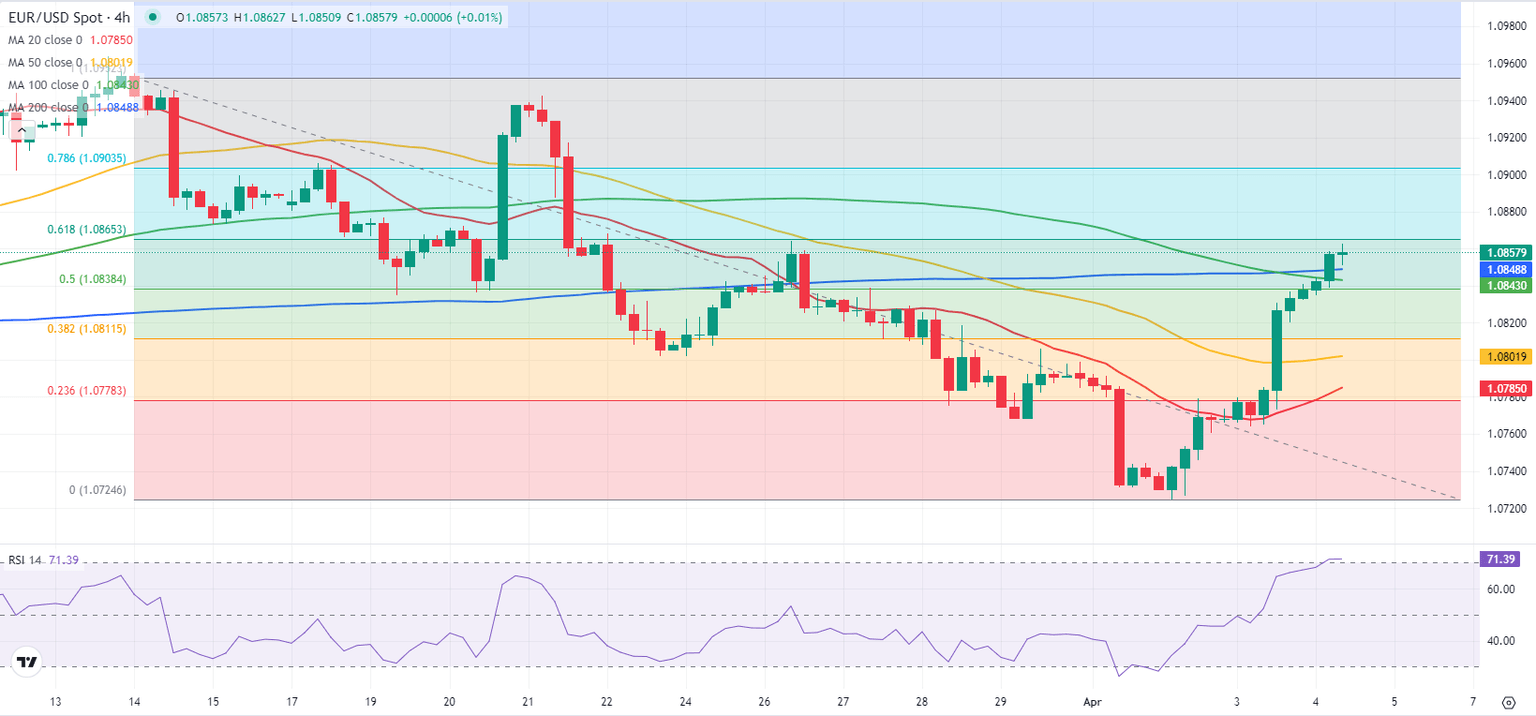EUR/USD Forecast: Euro rally could lose steam ahead of key US data
- EUR/USD holds steady near 1.0850 following a two-day rally.
- Investors could refrain from taking large positions ahead of the US jobs report.
- The near-term technical outlook points to overbought conditions.

EUR/USD gathered bullish momentum and climbed to its highest level in over a week above 1.0850. The pair's near-term technical outlook points to overbought conditions as market focus shifts to key labor market data from the US on Friday.
Disappointing ISM Services PMI data from the US triggered a US Dollar (USD) selloff in the American session on Wednesday. The headline PMI declined to 51.4 from 52.6, showing a loss of momentum in the service sector's activity growth. More importantly, the Prices Paid Index fell to 53.4 from 58.6 to highlight a softening in the sector's input inflation.
Euro price this week
The table below shows the percentage change of Euro (EUR) against listed major currencies this week. Euro was the strongest against the Swiss Franc.
| USD | EUR | GBP | CAD | AUD | JPY | NZD | CHF | |
| USD | -0.60% | -0.17% | -0.14% | -1.03% | 0.24% | -0.87% | 0.47% | |
| EUR | 0.60% | 0.43% | 0.46% | -0.43% | 0.83% | -0.28% | 1.07% | |
| GBP | 0.17% | -0.43% | 0.02% | -0.86% | 0.39% | -0.71% | 0.63% | |
| CAD | 0.14% | -0.45% | -0.04% | -0.89% | 0.38% | -0.75% | 0.61% | |
| AUD | 1.02% | 0.43% | 0.85% | 0.88% | 1.26% | 0.15% | 1.49% | |
| JPY | -0.24% | -0.82% | -0.40% | -0.37% | -1.24% | -1.10% | 0.23% | |
| NZD | 0.86% | 0.27% | 0.71% | 0.74% | -0.15% | 1.10% | 1.33% | |
| CHF | -0.47% | -1.07% | -0.63% | -0.60% | -1.50% | -0.23% | -1.34% |
The heat map shows percentage changes of major currencies against each other. The base currency is picked from the left column, while the quote currency is picked from the top row. For example, if you pick the Euro from the left column and move along the horizontal line to the Japanese Yen, the percentage change displayed in the box will represent EUR (base)/JPY (quote).
In the meantime, Federal Reserve (Fed) Chairman Jerome Powell repeated that they are not in a rush to lower the policy rate and added that they have time to let incoming data guide their policy decisions.
In the second half of the day, the US economic docket will feature weekly Initial Jobless Claims data, which is forecast to edge higher to 214,000 from 210,000. A reading close to 200,000 could help the USD stage a rebound while an increase beyond 220,000 could force the currency to continue to weaken against its rivals.
Nevertheless, the US Bureau of Labor Statistics will release the Nonfarm Payrolls data on Friday and market participants could move to the sidelines while waiting for the jobs report.
EUR/USD Technical Analysis
The Relative Strength Index (RSI) indicator on the 4-hour chart climbed above 70, pointing to overbought conditions in the near term.
On the upside, 1.0865 (Fibonacci 61.8% retracement of the latest downtrend) aligns as immediate resistance before 1.0900 (Fibonacci 78.6% retracement) and 1.0950 (beginning point of the downtrend).
The 200-period and the 100-period Simple Moving Averages (SMA) form strong support at 1.0850-1.0845. In case EUR/USD falls below that area and starts using it as resistance, additional losses toward 1.0800 (psychological level) and 1.0780 (Fibonacci 23.6% retracement).
Euro FAQs
The Euro is the currency for the 20 European Union countries that belong to the Eurozone. It is the second most heavily traded currency in the world behind the US Dollar. In 2022, it accounted for 31% of all foreign exchange transactions, with an average daily turnover of over $2.2 trillion a day. EUR/USD is the most heavily traded currency pair in the world, accounting for an estimated 30% off all transactions, followed by EUR/JPY (4%), EUR/GBP (3%) and EUR/AUD (2%).
The European Central Bank (ECB) in Frankfurt, Germany, is the reserve bank for the Eurozone. The ECB sets interest rates and manages monetary policy. The ECB’s primary mandate is to maintain price stability, which means either controlling inflation or stimulating growth. Its primary tool is the raising or lowering of interest rates. Relatively high interest rates – or the expectation of higher rates – will usually benefit the Euro and vice versa. The ECB Governing Council makes monetary policy decisions at meetings held eight times a year. Decisions are made by heads of the Eurozone national banks and six permanent members, including the President of the ECB, Christine Lagarde.
Eurozone inflation data, measured by the Harmonized Index of Consumer Prices (HICP), is an important econometric for the Euro. If inflation rises more than expected, especially if above the ECB’s 2% target, it obliges the ECB to raise interest rates to bring it back under control. Relatively high interest rates compared to its counterparts will usually benefit the Euro, as it makes the region more attractive as a place for global investors to park their money.
Data releases gauge the health of the economy and can impact on the Euro. Indicators such as GDP, Manufacturing and Services PMIs, employment, and consumer sentiment surveys can all influence the direction of the single currency. A strong economy is good for the Euro. Not only does it attract more foreign investment but it may encourage the ECB to put up interest rates, which will directly strengthen the Euro. Otherwise, if economic data is weak, the Euro is likely to fall. Economic data for the four largest economies in the euro area (Germany, France, Italy and Spain) are especially significant, as they account for 75% of the Eurozone’s economy.
Another significant data release for the Euro is the Trade Balance. This indicator measures the difference between what a country earns from its exports and what it spends on imports over a given period. If a country produces highly sought after exports then its currency will gain in value purely from the extra demand created from foreign buyers seeking to purchase these goods. Therefore, a positive net Trade Balance strengthens a currency and vice versa for a negative balance.
Premium
You have reached your limit of 3 free articles for this month.
Start your subscription and get access to all our original articles.
Author

Eren Sengezer
FXStreet
As an economist at heart, Eren Sengezer specializes in the assessment of the short-term and long-term impacts of macroeconomic data, central bank policies and political developments on financial assets.


















